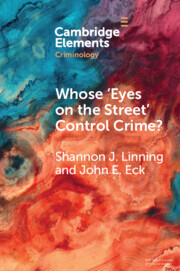Element contents
Whose 'Eyes on the Street' Control Crime?
Published online by Cambridge University Press: 09 November 2021
Summary
Keywords
- Type
- Element
- Information
- Series: Elements in CriminologyOnline ISBN: 9781108954143Publisher: Cambridge University PressPrint publication: 02 December 2021
References
- 30
- Cited by

